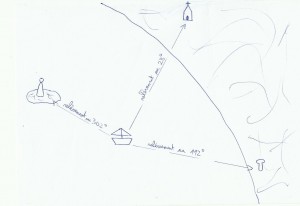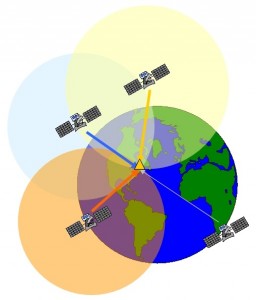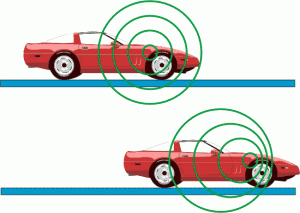Quite easy to use(you press a button and pouf you have your position), the gps device is more difficult to understand, the main thing is that it will use the time as a measure for determining distances(between us and the appropriate satellites)and by intersection of these distances(like a point 3 of 3 bearings)it will display our latitude and longitude. Currently the number of satellites used for this system exceeds 24, and they orbit the earth at approximately 11000 miles. There is much to be sure that at least three are visible at any point on the earth at the same time. We will also see that the gps involves the laws of relativity of Einstein to obtain the best accuracy, no no this is not bullshit!
1) A three bearings point in 3 dimensions
In coastal navigation when we do a three bearings point and we draw it on the chart, we work on a 2 dimensions plan.
For positioning with gps it is the same idea except that here we work in 3D. A satellite's bearing will not store us on a straight line but on a sphere with the satellite as it center. The intersection of these three spheres indicates two positions, one on earth and one outside which will not be kept. The compass bearing gives us an angle and the satellite gives us a distance.
In this diagram we see the presence of a fourth satellite, so what it's doing there ?
The measurement of the distance between the satellite and us is the product of the light's speed(speed signal, 300000 km / s in a vacuum about)with the time signal reception, So to get an accurate measurement of this distance it requires that the internal clock of the satellites and the receiver are synchronized together and very accurate. If a satellite sends a signal at time 1 and gps catches it at time 2, travel time so the distance can not be known only if the clocks are synchronized, if they are not traveling time is wrong and finally calculated distance is false.
For a nanosecond precision satellites are equipped with atomic clocks , and they are all synchro between them. Problem: an atomic clock costs the skin's bottom, an arm, head's eyes and a bag so it wasn't possible to set it up in each gps. We have found a parade, gps is adjusted depending on satellites clocks with the help of a fourth satellite. If gps clock is well adjusted, the positioning sphere of the fourth satellite must cut the others in the same place (the small triangle in the draw). If this is not the case, gps corrects the time of its clock to find that, crazy, isn't it ? actually the gps not only gives an accurate point but also the time with an atomic precision because it constantly adjusts its time with satellites, equipped with atomic clocks.
2) Everything is relative…
As we have just seen the principle of GPS is based on measuring the travel time of electronic signals traveling at the speed of light, so it is important that clocks on earth and on satellites are synchronized, or the use of a fourth satellite is not enough…because the local time of the receiver( gps) and satellites do not evolve in the same way especially because of the wide difference in speed between them, in short it's the mess.
a. Relativity
It challenges the notion of absolute time. Previously it was believed that the time followed the same way and at the same speed throughout the universe and for everyone, and that the speed of light was infinite. In fact this is light's speed which is an absolute concept and limited, time is relative to the subject according to its speed relative to the speed of light. The twin paradox(also called clock paradox)illustrates the problem. We take two twins, one is dropped in a spacecraft able to move at a speed close to the light, and the other stays on earth. If the first goes to buy bread on Osiris (an exoplanet used for the exemple)by spacecraft, he will come back younger than his twin brother who has stayed on earth! To understand the phenomenon bravest will investigate the equations of Lorentz, well explained in the book “relativity” of Einstein, or on youtube there is an episode of the fourth dimension that sum up this thing. This is only valid when the speed differences are close to the light's speed, we're not going to age more slowly by doing 300 km per hour on the highway! Its's more the contrary…
Gps satellite moves about 14000 km/hour, therefore its speed is not negligible compared with light's speed…
Simple equation to notice this:
S=√(1-v²/c²)
S is the contraction factor, indicates the relative changes of time and space of an object at the speed v. For our spacecraft which is turning at 150000 km/s it gives:
S=√(1-150000²/300000²)=0.87, time in the shuttle will evolve at 87% of reference's time(the earth), so the time in the shuttle will run 13% slower than time of the Earth.
For our satellite that moves very quickly compared to our gps receiver that create a small but significant shift of 8 microseconds per day of delay in relation to our time.
b. General relativity
Everyone knows the Doppler effect, particularly the police that uses it for money… motionless in the street, If a motorcycle is approaching us the engine noise will rise in high pitched, and when it moves away from us that turns in deep.
If sound's speed in air is known(approx 340m / s)it can be possible to calculate car's speed. In fact this effect also works with light! and as the speed of light is related to the time…This is still the mess!
In our case then we'll talk about gravitational Doppler effect(to manage to fix it in a sentence during a conversation it's hard), explanation: the light may be seen as a form of data transfer via photons, particles without mass thus capable of reaching the maximum speed of 300000 km/s . But even massless photons are deflected by gravity, and gravity is equivalent to an acceleration. Further light is both a wavelength(as sound…)and a particle movement. Conclusion: a gravity field accelerates photons and increases frequencies of light. in fact light frequency will be increased when the satellite will send its signal to us, and it will be slowed down when the signal goes from the bottom to upwards due to gravity. In fact the strongest gravitational field on earth slows down light and therefore time relative to the gravitational field of satellite.
This principle of general relativity causes a shift of 46 microseconds per day between our local time and satellite's local time(46 microseconds to substract for us ).
The GPS must correct per day a shift of 38 microseconds roughly, otherwise it would lose every day 12 km of accuracy!(299792458 m / s multiplied by 38 microseconds gives almost 12 km) Despite its ease of use, gps finally uses complex concepts.


